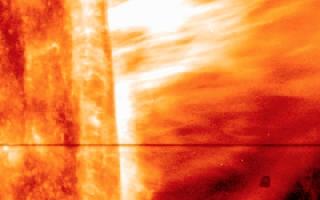
A coronal mass ejection burst off the side of the sun on May 9, 2014. The giant sheet of solar material erupting was the first CME seen by NASA's Interface Region Imaging Spectrograph, or IRIS. Image Credit: NASA/LMSAL/IRIS/SDO/Goddard
WASHINGTON (PTI): NASA's newest solar observatory has captured a colossal coronal mass ejection erupting from the Sun in extraordinary detail.
According to the US space agency, during the time of the ejection observed on May 9, a curtain of solar material erupted outwards at speeds of 1.5 million miles per hour.
The field of view for this imagery is about five Earths wide and about seven-and-a-half Earths tall.
This was the first CME observed by the Interface Region Imaging Spectrograph, or IRIS, which was launched in June 2013 to peer into the lowest levels of the Sun's atmosphere with better resolution than ever before.
"We focus in on active regions to try to see a flare or a CME," said Bart De Pontieu, the IRIS science lead at Lockheed Martin Solar & Astrophysics Laboratory in Palo Alto, California.
"And then we wait and hope that we'll catch something.
This is the first clear CME for IRIS so the team is very excited," De Pontieu said.
The IRIS imagery focuses in on material of 30,000 kelvins at the base, or foot points, of the CME, NASA said.
 Previous Article
Previous Article Next Article
Next Article













The Indian Air Force, in its flight trials evaluation report submitted before the Defence Ministry l..
view articleAn insight into the Medium Multi-Role Combat Aircraft competition...
view articleSky enthusiasts can now spot the International Space Station (ISS) commanded by Indian-American astr..
view article